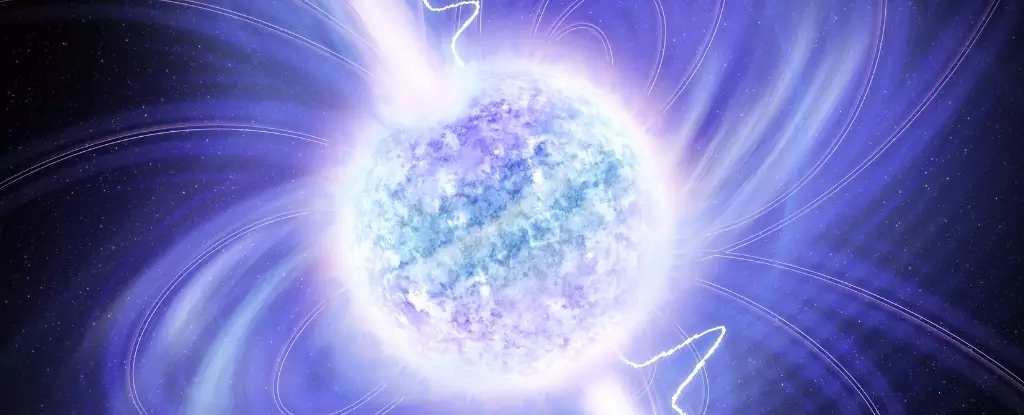The universe is a tapestry of enigmatic phenomena, and pulsars—highly magnetized, rotating neutron stars—serve as some of its most fascinating threads. As they spin, these astronomical objects emit beams of electromagnetic radiation, producing radio pulses akin to the guiding beams of a lighthouse. This characteristic behavior has led to their naming as pulsars, and they typically rotate at astonishing speeds, often completing a full rotation in mere seconds. However, recent advancements in astrophysical research have unveiled a puzzling anomaly: a newly discovered object that emits radio waves at a significantly slower pace, challenging our established understanding of neutron stars.
In a groundbreaking study published in *Nature Astronomy*, researchers revealed the discovery of the slowest rotating pulsar known to date, named ASKAP J1839-0756. This object spins once every 6.5 hours, a rotation rate that seems to defy the norms of pulsar behavior as we understand them. The discovery was made using the Australian Square Kilometre Array Pathfinder (ASKAP) radio telescope, situated in Western Australia. During routine observations, ASKAP J1839-0756 stood out due to the absence of any previously documented astronomical entity at its position. The radio emissions from this unusual object exhibited a striking trait: its brightness diminished by a staggering 95% within a mere 15 minutes, drawing attention and prompting further investigation.
The researchers initially identified only a single burst during the first observation, leading them to conduct additional monitoring with not only ASKAP but also with other sophisticated telescopes, including the Australia Telescope Compact Array and South Africa’s MeerKAT telescope. A series of observations eventually affirmed the periodic nature of the source, demonstrating that it indeed emitted two distinct pulses separated by 6.5 hours.
What makes ASKAP J1839-0756 particularly intriguing is its existence as a pulsar with such a slow rotation—contrary to the prevailing theories that posit neutron stars decelerate to a point where they cease radio emissions altogether, typically when their spin rates drop to roughly one rotation per minute. The traditional understanding implies that as pulsars age, they gradually lose rotational energy, emitting radio waves less frequently until they eventually stop entirely. In essence, the discovery of ASKAP J1839-0756 serves as a challenge to this established thinking and compels astronomers to reconsider the constraints imposed on neutron star behavior.
Interestingly, this pulsar is uniquely positioned in relation to Earth in such a way that allows observers to detect radio emissions not just from one magnetic pole, which is more common, but from both. The phenomenon of receiving pulses from both poles—referred to as interpulses—grants astronomers unprecedented insights into the geometry and magnetic field configuration of pulsars. Given that only about 3% of pulsars have such an alignment, ASKAP J1839-0756 stands as a rare case study that could help elucidate unresolved questions about the alignment dynamics of pulsars as they age.
The tantalizing question lingers: what fuels this cosmic oddity? Speculation abounds among astronomers. A plausible theory suggests that ASKAP J1839-0756 could be classified as a magnetar—an exceptionally magnetized neutron star capable of generating radio emissions through mechanisms distinct from traditional pulsars. While magnetars can sustain radio emissions at reduced spin rates, this particular object could stand as a unique entity within even this rare classification, as most magnetars maintain periods measured in seconds, not hours.
Some researchers ponder the possibility that ASKAP J1839-0756 may even represent a less understood type of astronomical body, such as a white dwarf—the remnant core of lower-mass stars. Typically, white dwarfs spin much slower than neutron stars; however, it remains an enigma as no isolated examples have been confirmed to emit radio pulses. The absence of supporting evidence or observations in other wavelengths makes it difficult to define ASKAP J1839-0756’s true nature.
The discovery of ASKAP J1839-0756 serves as a potent reminder of the universe’s propensity to defy established understanding. As researchers diligently monitor this remarkable object, fundamental questions regarding the mechanics and behavior of neutron stars and other stellar remnants will inevitably be revisited. The perplexing interplay between slow rotation, radio emissions, and interpulses compels astronomers to delve deeper into the unknown, ultimately expanding our comprehension of cosmic entities and their evolution.
In essence, ASKAP J1839-0756 is emblematic of the mysteries that abound in the cosmos. It illustrates how, even in an age of heightened astronomical knowledge, the universe retains its capacity to surprise and challenge our perceptions. As we advance further into the depths of space exploration, we are reminded that even the most seemingly settled areas of research can warrant considerable reconsideration, leaving open the door to the possibility of new discoveries that await us among the stars.

